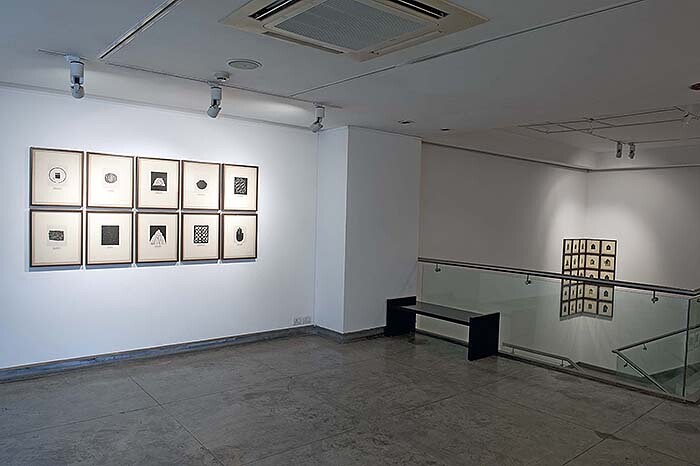“What’s not to like?,” a fellow critic concurred as I waxed lyrical about Zarina’s solo show, which I had seen a few days before in Delhi. The opening was timed to coincide with the India Art Fair, around which a number of glittering events have coalesced in what has become the country’s art capital. Inscribed in gold, the black cardboard invitation and matching catalog cover depict the bare outline of a golden house from Folding House (2014), a set of 25 collages from which the exhibition takes its title. A house divided, and split down the middle by a neat dividing line, unmistakably alludes to the 1947 partition of India and Pakistan. As a child growing up in Northern India (she was born in 1937), the artist experienced firsthand the massive population displacement and bloodshed that ensued; her work could hardly be accused of lacking political edge.
But the critic’s question—with its hint of underlying criticism and the implication that Zarina’s delicate creations, fashioned out of precious and handmade materials, were simply too alluring for their own good—nagged at me. To be sure, there is an element of material fetishism in the artist’s work, as the elaborate and at times long-winded descriptions of her chosen media attest. Take City (2013) and its companion piece Wandering Souls (2012), for example: “Collage with pewter leaf on Indian handmade paper stained with Sumi ink, dusted with gold powder and mounted on Arches Cover Buff paper.” And yet, this attention to detail may be equally seen as a way of promoting traditional, craft-based techniques. For Zarina, who honed her printmaking skills in Bangkok, Tokyo, and Paris, ink is not just ink, and paper is not just any old paper. Mounted against the muted, grainy background of Arches Cover or Somerset stock, which is wispy around the edges, each type of image calls for its own variety of handmade paper—from Japanese Kozo to Indian and Nepalese. The artist subjects them all to staining, folding, threading, and puncturing in turn.
Zarina’s refined appreciation of the papermaking craft goes hand in hand with that of Urdu handwriting and calligraphy, another dying art and declining language, which happens to be her mother tongue. Having grown up in a bookish household, literary allusions abound in her work in the form of poetic titles or as full-fledged quotations that accompany the image in the illustrated manuscript tradition. Taken from a couplet by the revolutionary and Urdu poet Faiz Ahmad Faiz, the title of the “Companions of the End of the Night” series (2013), for example, appears handwritten in the fluid, ornamental Urdu script on its own piece of paper, and is collaged beneath ink-stained drawings, pin-punctured to form constellations of tiny holes like those found in the Folding House image on the invitation. Less-polished handwriting can also be seen in Urdu Proverbs (2011), collaged beneath ten rough-hewn woodblocks that illustrate just as many Urdu proverbs, and in Echo (2013), digitally printed with the text of a letter from Zarina’s sister on a narrow strip of Kozo paper, which forms a square within a square.
No reproduction can do justice to the sculptural quality of these layered collages, woodcuts, and prints, which are poised between two and three dimensions, nor could it adequately convey the subtle variations in tone and texture of the paper she uses. The other materials Zarina works with, like pewter and 22-carat gold leaf (favored in India and across South Asia), create even greater relief and sharper, more pronounced edges and lines. For instance, in Compass (2013), an imperfectly round shape made up of thin triangular strips of pewter leaf, which appears cracked in places, is echoed by a diminutive circle inching its way into one of the triangles. Even in Zarina’s more overtly two-dimensional works, there is a tension between the fragility and lightness of the materials deployed and the impression of solidity and weight they convey.
The latter of these dominates the three sculptural works displayed in the downstairs gallery space. Placed on a low-lying plinth, Enso (Zen Circle) (2012), a string of black marble disks sealed with red paper at both ends (in a rare departure from the artist’s restricted palette of gold, black, and creamy whites), gives consistency to the titular Japanese ink drawings made in a swift brush stroke intended to free up creative energy. Nestled in one of the room’s corners, the rosary-like Tasbin (2011) consists of outsized black-and-gold maple-wood prayer beads strung together. Hung from the ceiling with gold wire of varying length, the 101 bulbs carved out of white marble with a dazzling, 22-carat gold encasing in Frozen Light (2013) transform the fragile glass-and-metal object into something rock solid.
Arte Povera this certainly isn’t. Zarina’s recourse to expensive materials enhances the value of her work (not least in the eyes of collectors) with marble, gold, and paper so fine that you would indeed think twice before marking on it. As Zarina confides in her artistic statement in the catalog: “I am still overwhelmed by my doubts and hesitations before I make a mark on paper.” Fortunately, for our sake, the artist manages to overcome these inhibitions, channeling the creative impulse necessary to move beyond doubts and hesitations into works of exquisite beauty.










